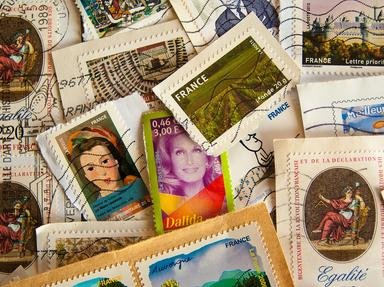Quiz Answer Key and Fun Facts
1. The first stamp that caused us problems was one showing a girl wearing a very pretty dress. There was what looked like a denomination - 40 f - and the words "Magyar Posta." We could not find a country called Magyar in our atlas. Can you tell us what country the stamp came from?
2. We found some stamps from the USA which we recognized, some from France that were easy to identify, and a couple from Argentina that had the country's name printed on them - the same as English! But then we came across a very odd stamp. It was red, had a man's face in profile, with a crown over it. But there was no country's name on it! Just the words "Postage Revenue," and "1d" in a circle. My nephew and I are both at a loss. The man looks like some guy with a bad stutter played by Colin Firth in a movie I saw a few years ago, but I can't place him. Can you tell me what country this stamp is from?
3. Thank goodness most stamps are easy to identify. So I said until we came across a green one showing what looks like a dam, and the words "30 Helvetia" across the bottom. As I was puzzling over this, my nephew smugly announced that he knew what country it was from. I didn't believe him, but it turns out he was right. What country was it (hint: it's famous for its cheese)?
4. I think these next two stamps are from the same country, because they were found together in the same glassine envelope. But one looks like a British stamp with the words "Saorstat Eireann 1922" overprinted on it, and the second shows a man in a military uniform named Cathal Brugha, and the word "Éire" in the upper left-hand corner. We're out of ideas! Can you tell us what country these stamps are from?
5. We added a lot of stamps to the album without difficulty, but then we stumbled across one with the words "Republika Hrvatska" on it. There's a beautiful photo of what looks like a lighthouse near the ocean. At the bottom of the stamp are the words "Veli rat" and "3.10." That's all we have to go on! Can you tell us which country this stamp comes from?
6. Thank goodness most countries' stamps have their name printed on them in words that correspond, more or less, to English. But then we come upon one that is very odd-looking. It is unused, and is printed in pale blue. It has four horns placed around a circle, and in the circle are the words, "50 Milliarden." At the top it says "Deutsches Reich," and at the bottom is "50000000000M." I seem to recall that "milliard" is what we Americans call a billion, but that doesn't help identify the stamp. Can you tell us what country would have produced a 50 billion something stamp?
7. Just when we thought it couldn't get more difficult, we find a stamp with a picture of what looks like some kind of ancient temple on it. There's writing on the stamp, but it's in a funny looking alphabet - neither my nephew nor I can make heads nor tails of it. The only thing we can read is a single word, "Hellas." Neither of us has heard of a country called that. Can you tell us where this stamp is from?
8. Another stamp with funny writing on it! We're really puzzled over this one. It shows what looks like a rocket ship taking off. There's a lot of funny writing we can't read. But in the lower left-hand corner, we see "1972," "6K," and what looks like "NOYTA CCCP." Can you please help us? We've tried everything we can think of. What country issued this stamp?
9. Another puzzler. This is a very plain looking stamp. It shows three leopards, and the words "Eesti 10s." That's all! I thought maybe it could stand for East Something-or-other, but that avenue did not pan out. We need your help again. Where did this stamp come from?
10. We're almost done. We have placed hundreds of stamps in my nephew's album, and he is well on his way to becoming a knowledgeable stamp collector! But as luck would have it, the final stamp we have to identify has us both stumped again. It shows some kind of flower (cherry blossoms?) and some kind of oriental writing we can't make out. Our only clue is that in the upper left corner it says "NIPPON," and there's the numeral 50 at the bottom. But I'm afraid that's not enough for us to identify it. Can you help us out and tell what country this stamp is from?
Source: Author
daver852
This quiz was reviewed by FunTrivia editor
ozzz2002 before going online.
Any errors found in FunTrivia content are routinely corrected through our feedback system.

